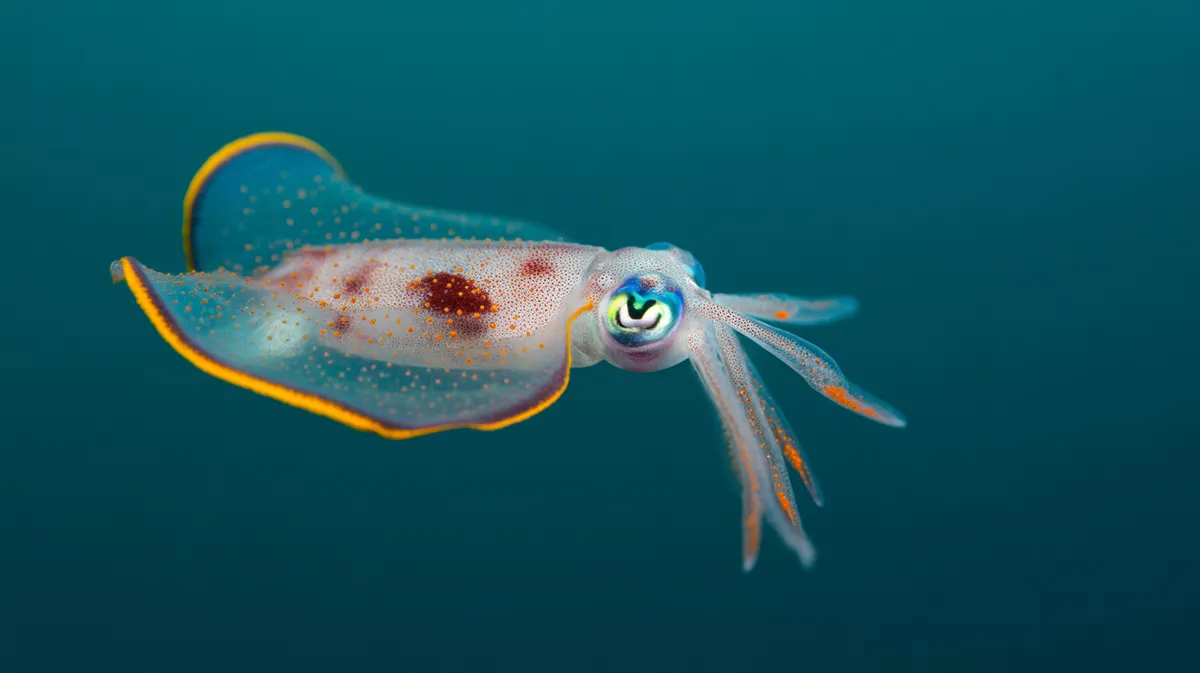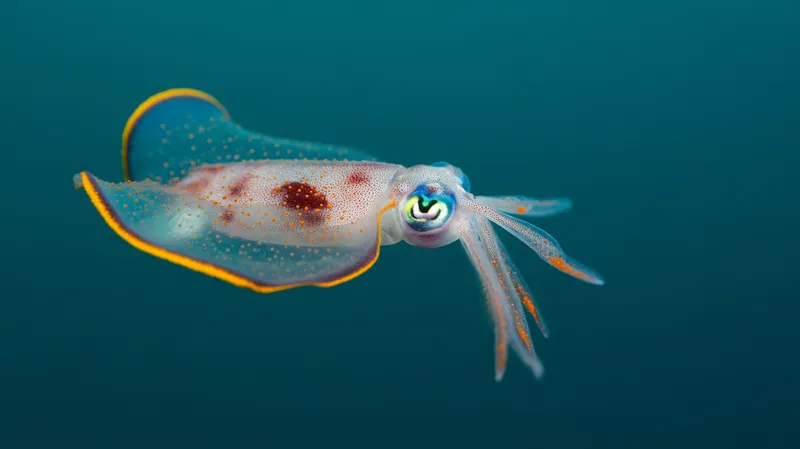
Firefly Squid
Watasenia scintillans

Meet the Firefly Squid
The Firefly Squid is a small, bioluminescent cephalopod native to the deep waters of the western Pacific Ocean, particularly around Japan. This remarkable squid is famous for its ability to emit dazzling blue light from thousands of photophores covering its body, creating mesmerizing underwater displays. Each spring, millions migrate to the shores of Toyama Bay to spawn, attracting both scientists and tourists. The Firefly Squid is an important part of marine food webs and is also fished commercially in Japan.
Classification
Invertebrate
Habitat
Deep ocean waters (200-400 meters), coastal bays during spawning season
Diet
Carnivore
Lifespan
1 year
Conservation
Least Concern
Weight
10-20 grams
📖Fascinating Facts
Bioluminescent Master
The Firefly Squid possesses thousands of light-producing organs called photophores, allowing it to create intricate patterns and flashes of blue light.
Seasonal Visitor
Every spring, massive numbers of Firefly Squid migrate from the deep sea to the shallow waters of Toyama Bay to spawn, attracting large gatherings of observers.
Unique Eyes
This squid has two types of eyes—one suited for deep-sea vision and another for shallow water—giving it exceptional adaptability to different light conditions.
📋Detailed Description
The Firefly Squid (Watasenia scintillans) is a small cephalopod, typically measuring 7–8 centimeters in mantle length, with females generally larger than males. Its body is slender and cylindrical, with eight arms and two longer tentacles equipped with suckers for capturing prey. The most striking feature is the presence of thousands of photophores—specialized light-producing organs—distributed along the ventral surface, arms, and around the eyes, enabling the squid to emit vivid blue bioluminescence. This light display is used for communication, camouflage, and predation. The Firefly Squid is a vertical migrator, spending daylight hours at depths of 200–400 meters and ascending to shallower waters at night to feed. It exhibits a semelparous life cycle, breeding only once before dying. During the spawning season (March to June), vast numbers gather in coastal bays, particularly Toyama Bay, where females release eggs in synchrony, creating spectacular light shows. Their diet consists mainly of small fish, crustaceans, and other cephalopods, which they hunt using both vision and bioluminescent lures. The species plays a vital ecological role as both predator and prey, supporting diverse marine food webs. Commercial fisheries target the squid during spawning aggregations, and it is considered a delicacy in Japan.
💡 Did you know?
The Firefly Squid’s bioluminescent displays are so bright that they can sometimes be seen from the surface, lighting up entire sections of coastline during their spawning season.
🔬Research & Sources
🎭Behavior & Social Structure
Firefly Squid are primarily nocturnal, exhibiting diel vertical migration: they remain in deeper waters during the day to avoid predators and ascend to the upper water column at night to feed. They are solitary hunters but form dense aggregations during the spawning season. Their hunting strategy involves using their photophores to attract prey or to create counter-illumination, masking their silhouette from predators below. Visual communication is believed to occur via complex light patterns, especially during mating. The squid's acute vision, with large, well-developed eyes, allows them to detect faint light and prey movements in the deep sea. Outside the breeding season, individuals are dispersed and largely solitary, with little evidence of social structure.
👶Reproduction & Life Cycle
Watasenia scintillans is semelparous, meaning individuals reproduce once and then die. Spawning occurs from March to June, peaking in April and May, when mature adults migrate en masse to shallow coastal waters. Females release between 300 and 4,000 eggs, which are fertilized externally as males deposit spermatophores onto the female's mantle or arms. The eggs are buoyant and drift in the plankton for several days before hatching into planktonic paralarvae. There is no parental care; adults die shortly after spawning. The life span is typically about one year, with rapid growth from hatchling to maturity. The synchronized spawning results in dense aggregations, increasing reproductive success and overwhelming predators.
🛡️Adaptations & Survival
The Firefly Squid's most notable adaptation is its sophisticated bioluminescent system, with three distinct types of photophores enabling precise control over light emission. This serves multiple functions: counter-illumination camouflage, prey attraction, and intraspecific signaling. Its large, asymmetrical eyes are adapted for detecting both faint and bright light, aiding in navigation and hunting across varying depths. The squid's streamlined body and powerful jet propulsion allow for agile swimming and rapid escape from predators. Its short life cycle and high fecundity are evolutionary strategies to cope with high predation rates and environmental variability. The ability to migrate vertically enables efficient exploitation of food resources and predator avoidance.
📚Research Sources
🎨Cultural Significance
In Japan, the Firefly Squid is celebrated both as a natural spectacle and a culinary delicacy. The annual spawning event in Toyama Bay is a major tourist attraction, with night cruises organized to witness the glowing masses. The squid is featured in local cuisine, often served as sashimi or boiled. It holds symbolic significance in Japanese culture, representing the transient beauty of nature. Historically, the bioluminescence has inspired folklore and poetry, and the squid's light has been used in scientific research on bioluminescence and vision.
🔬Recent Research & Discoveries
Recent research has focused on the molecular mechanisms of bioluminescence, revealing unique luciferin-luciferase systems and photophore structures. Studies on the squid's visual system have uncovered adaptations for detecting polarized light and low-light environments. Ongoing research investigates the ecological impacts of climate change on spawning behavior and distribution. Genomic studies are providing insights into cephalopod evolution and the genetic basis of bioluminescence. The Firefly Squid is also used as a model organism for studying neural control of light emission and cephalopod development.
🎥Wildlife Videos

Firefly Squid: A Light in the Deep | Forces of Nature | BBC Earth Science
Every year, firefly squid rise from the deep to spawn. Harnessing the chemistry inside their cells, they produce a spectacular ...
BBC Earth Science

Invisible Nature: The Glowing Squid | bioGraphic
Instead of hiding in the dark, the Hawaiian bobtail squid cruises through moonlit waters—and hides its own shadow. Directed by ...
bioGraphicMagazine

Invisible Light Show | Explorers in the Field
From the Education Resource Library: Explore the hidden world of biofluorescence and bioluminescence with marine biologist ...
National Geographic Education

SQUID #squid #marinelife #coral
Squid are marine cephalopods belonging to the order Teuthida, characterized by their elongated bodies, large eyes, and ten ...
Maxx Dreamer

Bioluminescent Mysteries: Creatures of the Deep and Dark
Bioluminescent Mysteries: Creatures of the Deep and Dark Dive into the mysterious world of bioluminescent creatures, from the ...
Fright Night Fables

Extraordinary flashing squids
Follow us on social media : Facebook : https://www.facebook.com/BestDocumentaryTV.
Best Documentary
🌍Habitat Information
The Firefly Squid typically inhabits Deep ocean waters (200-400 meters), coastal bays during spawning season environments. Firefly Squids have adapted to their environments with specialized features and behaviors.
Primary Habitat:
Deep ocean waters (200-400 meters), coastal bays during spawning season
More detailed habitat information will be available soon.
🛡️Conservation Status
The Firefly Squid is currently classified as Least Concern. Conservation efforts are crucial for preserving this species for future generations.
Common Threats:
- 🏠Habitat loss and fragmentation
- 🌡️Climate change impacts
- 🎯Hunting and poaching
- 🏭Human-wildlife conflict
⚠️Threats & Conservation Challenges
Currently, the Firefly Squid is listed as Least Concern, with stable populations due to its high reproductive output and wide distribution. However, localized overfishing during spawning aggregations, habitat degradation, and potential impacts from climate change (such as ocean warming and deoxygenation) pose emerging threats. Bycatch in other fisheries and pollution in coastal spawning areas can also affect populations. Monitoring is needed to ensure sustainable harvests, particularly in regions with intensive commercial fisheries. Population trends are closely tied to oceanographic conditions, with recruitment success fluctuating in response to changes in water temperature and currents.
🔬Scientific Classification
Scientific Name
Watasenia scintillans
Classification Hierarchy
🔍 About Taxonomic Classification
Taxonomic classification is a hierarchical system used by scientists to classify and organize living organisms based on shared characteristics and evolutionary relationships.
The system moves from broad categories (Kingdom) to increasingly specific ones, with each animal's scientific name typically consisting of its Genus and species.
📝Community Notes
Share your observations and insights about the Firefly Squid with our community of wildlife enthusiasts.
Join Our Community
Sign in to share your observations and connect with fellow wildlife enthusiasts.
Sign In to ContributeNo community notes yet
Be the first to share your observations about the Firefly Squid!
Explore Firefly Squid
Select a tab above to learn more about this amazing animal.
📸Photo Gallery
No photos available for this animal yet.
🌟Discover More Wildlife
Continue your journey of discovery with more fascinating animals from our database
